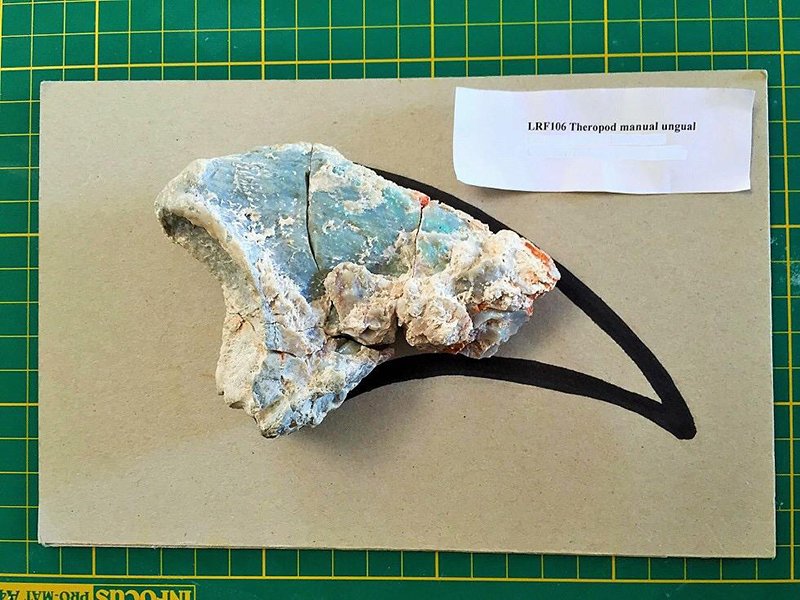New dinosaur is Australia’s largest carnivore

John Pickrell
John Pickrell

A NEW CARNIVOROUS dinosaur, with unusually long claws, has been revealed from fossil bones discovered by opal miners in the outback town of Lightning Ridge.
The animal would have been a large and relatively slender predator that prowled the waterways and floodplains of this region of the southern supercontinent of Gondwana 110 million years ago, during the mid-Cretaceous period.
“When I started looking at this fossil last year, I immediately recognised it was something new and important. Comparing it to other Australian and South American dinosaurs it became clear this was a megaraptorid – a relatively rare group of dinosaurs mostly known from Argentina,” says palaeontologist Dr Phil Bell, lead author of a study detailing the find in the journal Gondwana Research this week.
Australia’s biggest theropod dinosaur
“From our calculations this animal would have been about 7m in length, which is the biggest carnivorous dinosaur currently known from Australia,” adds Phil, who is based at the University of New England in Armidale, NSW.
The dinosaur, dubbed ‘Lightning Claw’ by the team behind the find, would have been a little larger than previous record-holder, 5m-long Australovenator. Australovenator is a related meat-eating megaraptorid that was described in 2009 from 94-million-year-old fossil remains found in Winton, Queensland.
The new fossil – consisting of a giant claw from the hand, parts of the arm, hip, and foot, pieces of ribs and a whole bunch of other fragments – was discovered in the 1990s tens of metres underground at the Carter’s Rush opal field south-west of Lightning Ridge.
“There were just enough clues in those bones to identify it as a megaraptorid dinosaur, and some features that marked it out as totally unique,” Phil says.
Terrifying dinosaur claws
He argues that the huge claws may have been used a little like giant grappling hooks to totally ensnare prey – megaraptorids lacked the huge and powerful jaws seen on other carnivorous dinosaurs, such as Tyrannosaurus rex.
The fossil, largely formed of blue-grey ‘potch’ or non-translucent opal, also displays occasional flashes of brightly coloured precious opal when it is moved in the light. In 2005, Lightning Ridge locals Rob and Debbie Brogan, who had aquired the fossil, donated it to the Australian Opal Centre (AOC). The AOC is building a museum collection of opalised fossil material at Lightning Ridge.
The original specimen was almost certainly more complete, but it wasn’t immediately recognised as a fossil, and parts were unfortunately destroyed before it was excavated, says Phil, who has chosen not to officially describe the animal as a new species until more complete material is found.
“It’s another little piece of the puzzle for Australian dinosaurs,” says Dr Steve Salisbury a palaeontologist at the University of Queensland in Brisbane, who was not involved with the study. He says that while we’ve known for a while from isolated bones and teeth that there were large carnivores at Lightning Ridge, nobody has had such complete remains or studied them in this much detail before.
“We’ve got tracks of things in Australia that are probably quite a bit larger – so there were bigger theropods out there – but it’s good to have some actual bony elements of one of these animals,” he adds.
 The partial claw of the new Lightning Ridge theropod (Image: John Pickrell).
The partial claw of the new Lightning Ridge theropod (Image: John Pickrell).
Predators of Gondwana
Steve says the study cements the idea that megaraptorid dinosaurs were the dominant carnivores in Australia in the mid-Cretaceous, and it may suggest lower diversity in general kinds of carnivorous dinosaurs in this part of the world than experts previously thought.
Megaraptorids are a group of medium-sized carnivores – including species such as Megaraptor, Aerosteon and Orkoraptor – which lived on the southern supercontinent of Gondwana during the Cretaceous period (other landmasses joined to Australia at this time included South America, Antarctica and Africa).
Australian dinosaurs have traditionally been thought of as aberrant or relict species, which lived on the periphery of the regions that gave birth to new radiations of dinosaur species, but Phil argues that the new find may turn that idea on its head.
“Lightning Claw, at 110 million years old, is the oldest member of this group of megaraptorid dinosaurs. There is also evidence from isolated bones that these animals also existed in Victoria at around the same time as at Lightning Ridge,” Phil says. “The evidence now points to an Australian origin for this group – so they first appeared here and branched out across Gondwana, colonising other parts of the supercontinent.”
Poorly known Australian dinosaurs
Phil – one of the leaders of last month’s Australian Geographic Society Lightning Ridge Fossil Dig – has been working for several years on studying a variety of undescribed dinosaur material alongside local palaeontologists Dr Elizabeth Smith and Jenni Brammall, based at the AOC. Italian scientists Drs Federico Fanti and Andrea Cau were also involved in studying the new material.
 Dr Phil Bell (at left) and Dr Federico Fanti sort opal mine tailings on the Australian Geographic Lightning Ridge Scientific Expedition (Image: John Pickrell).
Dr Phil Bell (at left) and Dr Federico Fanti sort opal mine tailings on the Australian Geographic Lightning Ridge Scientific Expedition (Image: John Pickrell).
Several other species of dinosaur – Walgettosuchus, Rapator and Fulgurotherium – have been described from opalised fossil material found at Lightning Ridge, but each of those fossils only consists of a single bone. Lightning claw is the second most complete carnivorous Australian dinosaur known after Australovenator.
The dinosaurs of Australia are relatively poorly known, with only around 17 well-defined species, most from very fragmentary remains.
Australian Geographic Society-supported research at Lightning Ridge will be continuing on our 2016 and 2017 fossil digs. Find out more about getting involved.
John Pickrell is the author of Flying Dinosaurs: How fearsome reptiles became birds, published by NewSouth Books in June 2014. Follow him on Twitter @john_pickrell.




